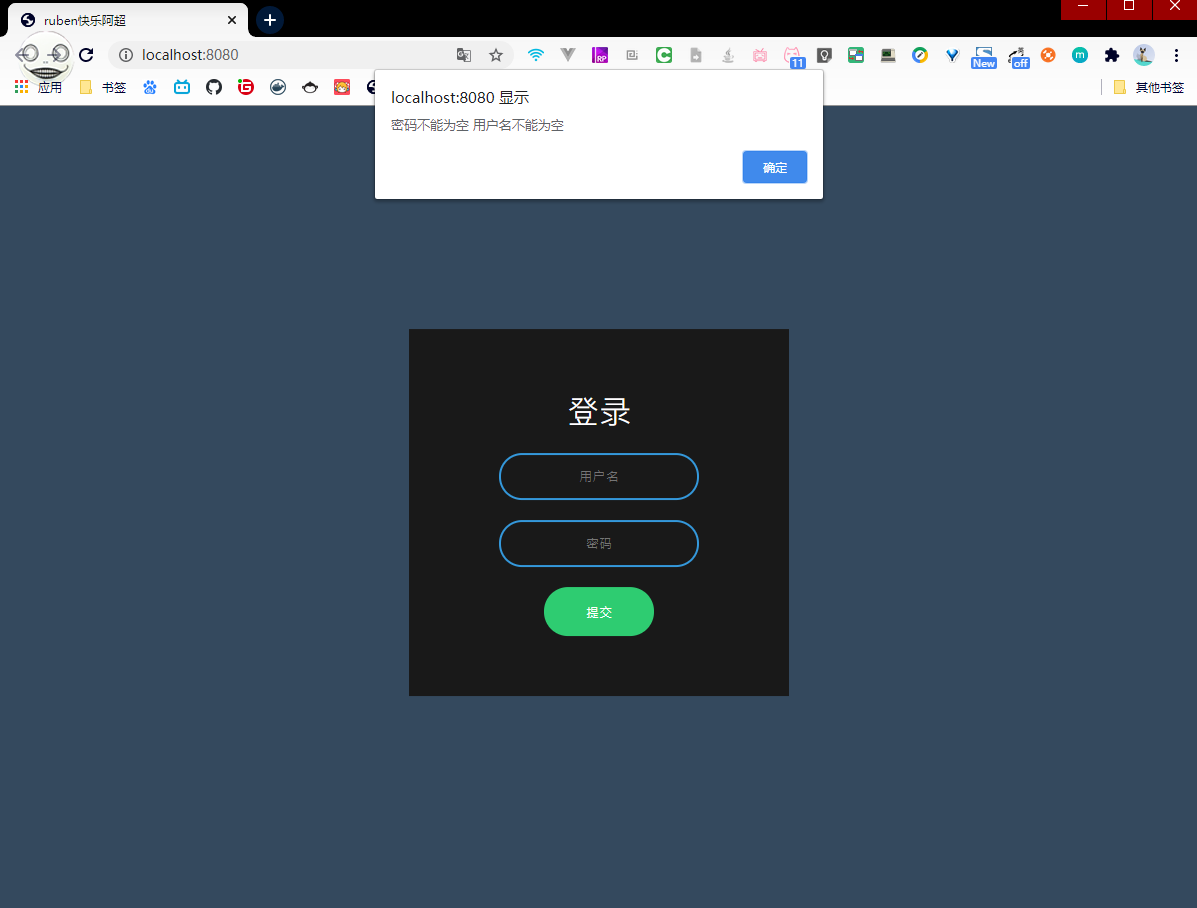阿超
>
spring实现Validator校验和全局异常处理
开整!
首先引入依赖
1
2
3
4
5
6
7
8
9
10
11
12
13
|
<dependency>
<groupId>org.hibernate.validator</groupId>
<artifactId>hibernate-validator</artifactId>
<version>6.1.5.Final</version>
</dependency>
<dependency>
<groupId>com.alibaba</groupId>
<artifactId>fastjson</artifactId>
<version>1.2.73</version>
</dependency>
|
在需要校验的实体类上加注解,这里我们写个接口,给它分个组
1
2
3
4
5
6
7
8
9
10
11
12
13
14
15
16
17
18
19
20
21
22
23
24
25
26
27
28
29
30
| package com.ruben.pojo;
import lombok.AllArgsConstructor;
import lombok.Data;
import lombok.NoArgsConstructor;
import javax.validation.constraints.NotBlank;
@Data
@NoArgsConstructor
@AllArgsConstructor
public class User {
@NotBlank(message = "用户名不能为空", groups = {UserCheck.class})
private String username;
@NotBlank(message = "密码不能为空", groups = UserCheck.class)
private String password;
public interface UserCheck {
}
}
|
然后在方法上加上注解,并指定分组
1
2
3
4
5
6
7
8
9
10
11
12
13
14
15
16
17
18
19
20
21
22
|
@PostMapping("login")
public Map<String, Object> login(@Validated({User.UserCheck.class}) @RequestBody User user) {
Map<String, Object> map = new HashMap<>(1 << 2);
String myUsername = "achao";
String myPassword = "ruben";
if (myUsername.equals(user.getUsername()) && myPassword.equals(user.getPassword())) {
map.put("success", true);
map.put("code", 200);
map.put("msg", "登录成功!");
} else {
map.put("success", false);
map.put("code", -629);
map.put("msg", "登录失败,用户名密码错误!");
}
return map;
}
|
这时候,我们发现已经抛出异常了

我们尝试去捕获这个异常MethodArgumentNotValidException
首先写个全局异常处理器
1
2
3
4
5
6
7
8
9
10
11
12
13
14
15
16
17
18
19
20
21
22
23
24
25
26
27
28
29
30
31
32
33
34
35
36
37
| package com.ruben.resolver;
import com.alibaba.fastjson.support.spring.FastJsonJsonView;
import org.springframework.http.HttpStatus;
import org.springframework.web.servlet.HandlerExceptionResolver;
import org.springframework.web.servlet.ModelAndView;
import javax.servlet.http.HttpServletRequest;
import javax.servlet.http.HttpServletResponse;
import java.util.HashMap;
import java.util.Map;
public class GlobalExceptionResolver implements HandlerExceptionResolver {
@Override
public ModelAndView resolveException(HttpServletRequest httpServletRequest, HttpServletResponse httpServletResponse, Object o, Exception e) {
e.printStackTrace();
ModelAndView modelAndView = new ModelAndView();
FastJsonJsonView fastJsonJsonView = new FastJsonJsonView();
Map<String, Object> map = new HashMap<>(1 << 2);
map.put("success", false);
map.put("code", HttpStatus.INTERNAL_SERVER_ERROR.value());
map.put("msg", "内部错误");
fastJsonJsonView.setAttributesMap(map);
modelAndView.setView(fastJsonJsonView);
return modelAndView;
}
}
|
然后在springmvc里一配
1
2
|
<bean id="handlerExceptionResolver" class="com.ruben.resolver.GlobalExceptionResolver"/>
|
我们随便写个int i = 2/0;的异常,发现全局异常处理器测试通过
然后精彩部分来了,我们debug发现这个MethodArgumentNotValidException异常全局异常处理器根本没进去!!!
那这样就没办法了吗?No No No!
这里我们采用AOP的方式
首先自定义个注解
1
2
3
4
5
6
7
8
9
10
11
12
13
14
15
16
17
18
19
| package com.ruben.annotation;
import java.lang.annotation.*;
@Documented
@Target({ElementType.METHOD})
@Retention(RetentionPolicy.RUNTIME)
public @interface Validator {
String value() default "bindingResult";
}
|
写完,在我们的方法上加上我们的注解和参数
1
2
3
4
5
6
7
8
9
10
11
12
13
14
15
16
17
18
19
20
21
22
23
24
25
|
@Validator
@PostMapping("login")
public Map<String, Object> login(@Validated({User.UserCheck.class})
@RequestBody User user,
BindingResult bindingResult) {
Map<String, Object> map = new HashMap<>(1 << 2);
String myUsername = "achao";
String myPassword = "ruben";
if (myUsername.equals(user.getUsername()) && myPassword.equals(user.getPassword())) {
map.put("success", true);
map.put("code", 200);
map.put("msg", "登录成功!");
} else {
map.put("success", false);
map.put("code", -629);
map.put("msg", "登录失败,用户名密码错误!");
}
return map;
}
|
然后写个简单的AOP来处理
1
2
3
4
5
6
7
8
9
10
11
12
13
14
15
16
17
18
19
20
21
22
23
24
25
26
27
28
29
30
31
32
33
34
35
36
37
38
39
40
41
42
43
44
45
46
47
48
49
50
51
52
53
54
55
56
57
58
59
60
61
62
63
64
65
66
67
68
| package com.ruben.aop;
import com.ruben.annotation.Validator;
import org.aspectj.lang.ProceedingJoinPoint;
import org.aspectj.lang.annotation.Around;
import org.aspectj.lang.annotation.Aspect;
import org.aspectj.lang.reflect.MethodSignature;
import org.springframework.context.support.DefaultMessageSourceResolvable;
import org.springframework.http.HttpStatus;
import org.springframework.stereotype.Component;
import org.springframework.validation.BindingResult;
import java.util.HashMap;
import java.util.Map;
import java.util.stream.Collectors;
@Aspect
@Component
public class ValidatorAop {
@Around("@annotation(validator)")
public Object validateParam(ProceedingJoinPoint joinPoint, Validator validator) {
String value = validator.value();
String[] parameterNames = ((MethodSignature) joinPoint.getSignature()).getParameterNames();
BindingResult bindingResult = null;
for (int i = 0; i < parameterNames.length; i++) {
if (value.equals(parameterNames[i])) {
bindingResult = (BindingResult) joinPoint.getArgs()[i];
}
}
Map<String, Object> map = new HashMap<>(1 << 2);
if (bindingResult != null && bindingResult.hasErrors()) {
map.put("success", false);
map.put("code", HttpStatus.BAD_REQUEST);
map.put("msg", bindingResult.getAllErrors().stream().map(DefaultMessageSourceResolvable::getDefaultMessage).collect(Collectors.joining(" ")));
return map;
}
try {
return joinPoint.proceed();
} catch (Throwable throwable) {
throwable.printStackTrace();
}
return null;
}
}
|
顺便放上一张我们的参数和提示截图


大功告成!


